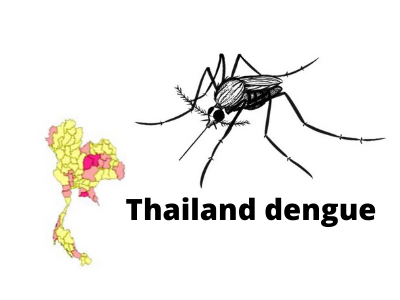By NewsDesk @infectiousdiseasenews
The Thailand Department of Disease Control (DDC) issued a national warning over dengue fever this week.

Since the beginning of the year, 14,136 patients from all 77 Thailand provinces have been reported. 11 deaths have been recorded.
The five provinces with the highest cases per 100,000 population include Rayong (73.00 per 100,000 population), Chaiyaphum (58.13 per 100,000 population) Khon Kaen (52.83 per 100,000 population)
Mae Hong Son (37.87 per 100,000 population) and Nakhon Ratchasima (36.92 per 100,000 population).
In Nakhon Ratchasima, aka Korat, the outbreak of dengue fever has killed two people and sickened 1,037 others year to date.
Dengue is a viral infection transmitted by the bite of an infected mosquito. There are four closely related but antigenically different serotypes of the virus that can cause dengue (DEN1, DEN 2, DEN 3, DEN 4).
Dengue Fever (DF) – marked by an onset of sudden high fever, severe headache, pain behind the eyes, and pain in muscles and joints. Some may also have a rash and varying degree of bleeding from various parts of the body (including nose, mouth and gums or skin bruising).Dengue has a wide spectrum of infection outcome (asymptomatic to symptomatic). Symptomatic illness can vary from dengue fever (DF) to the more serious dengue hemorrhagic fever (DHF).
Dengue Hemorrhagic Fever (DHF) – is a more severe form, seen only in a small proportion of those infected. DHF is a stereotypic illness characterized by 3 phases; febrile phase with high continuous fever usually lasting for less than 7 days; critical phase (plasma leaking) lasting 1-2 days usually apparent when fever comes down, leading to shock if not detected and treated early; convalescence phase lasting 2-5 days with improvement of appetite, bradycardia (slow heart rate), convalescent rash (white patches in red background), often accompanied by generalized itching (more intense in palms and soles), and diuresis (increase urine output).
Dengue Shock Syndrome (DSS) — Shock syndrome is a dangerous complication of dengue infection and is associated with high mortality. Severe dengue occurs as a result of secondary infection with a different virus serotype. Increased vascular permeability, together with myocardial dysfunction and dehydration, contribute to the development of shock, with resultant multiorgan failure.
WHO notes the incidence of dengue has grown dramatically around the world in recent decades. A vast majority of cases are asymptomatic and hence the actual numbers of dengue cases are underreported and many cases are misclassified.
One estimate indicates 390 million dengue infections per year (95% credible interval 284–528 million), of which 96 million (67–136 million) manifest clinically (with any severity of disease). Another study, of the prevalence of dengue, estimates that 3.9 billion people, in 128 countries, are at risk of infection with dengue viruses.
- Miami-Dade County reports 2nd West Nile virus case this month
- COVID-19: ImmunityBio vaccine part of ‘Operation Warp Speed’
- DEET: Safe for humans when used according to manufacturer instructions, according to University of Florida study
- Brazil: COVID-19 cases top 400,000, Deaths projected to be 125K by August
- COVID-19 RT-PCR testing: Beware of false negatives, researchers caution
- Severe malaria treatment receives FDA approval


